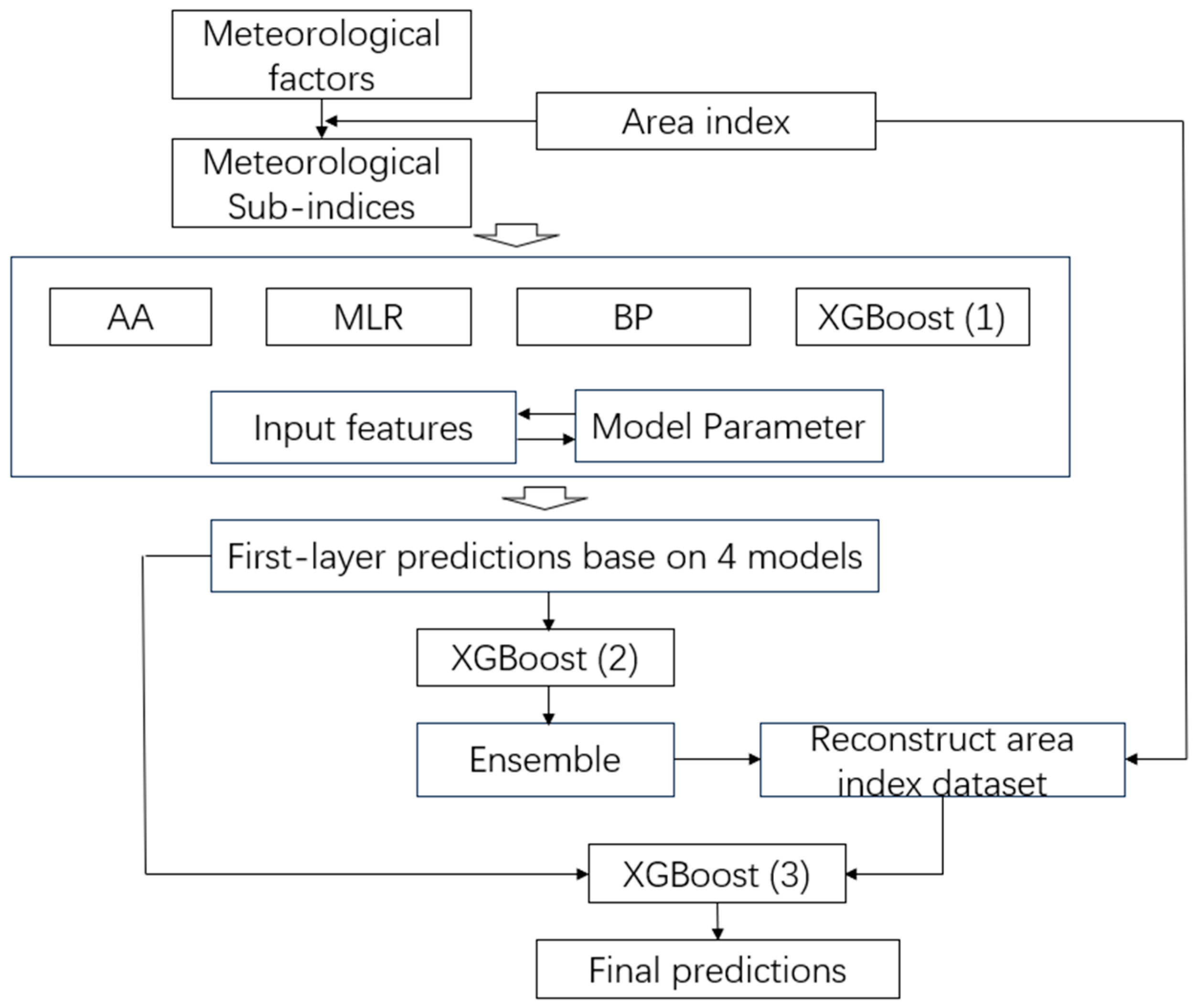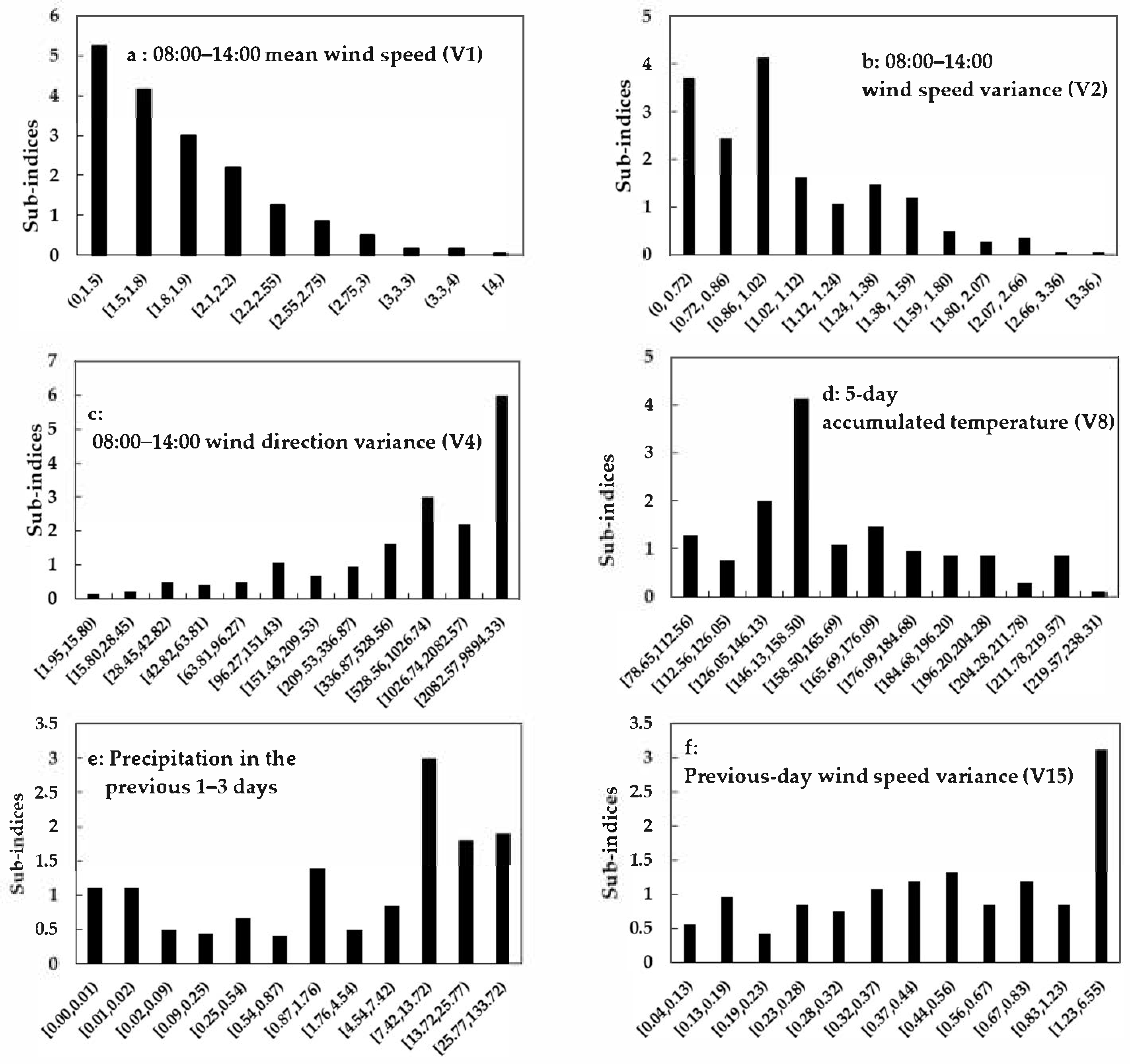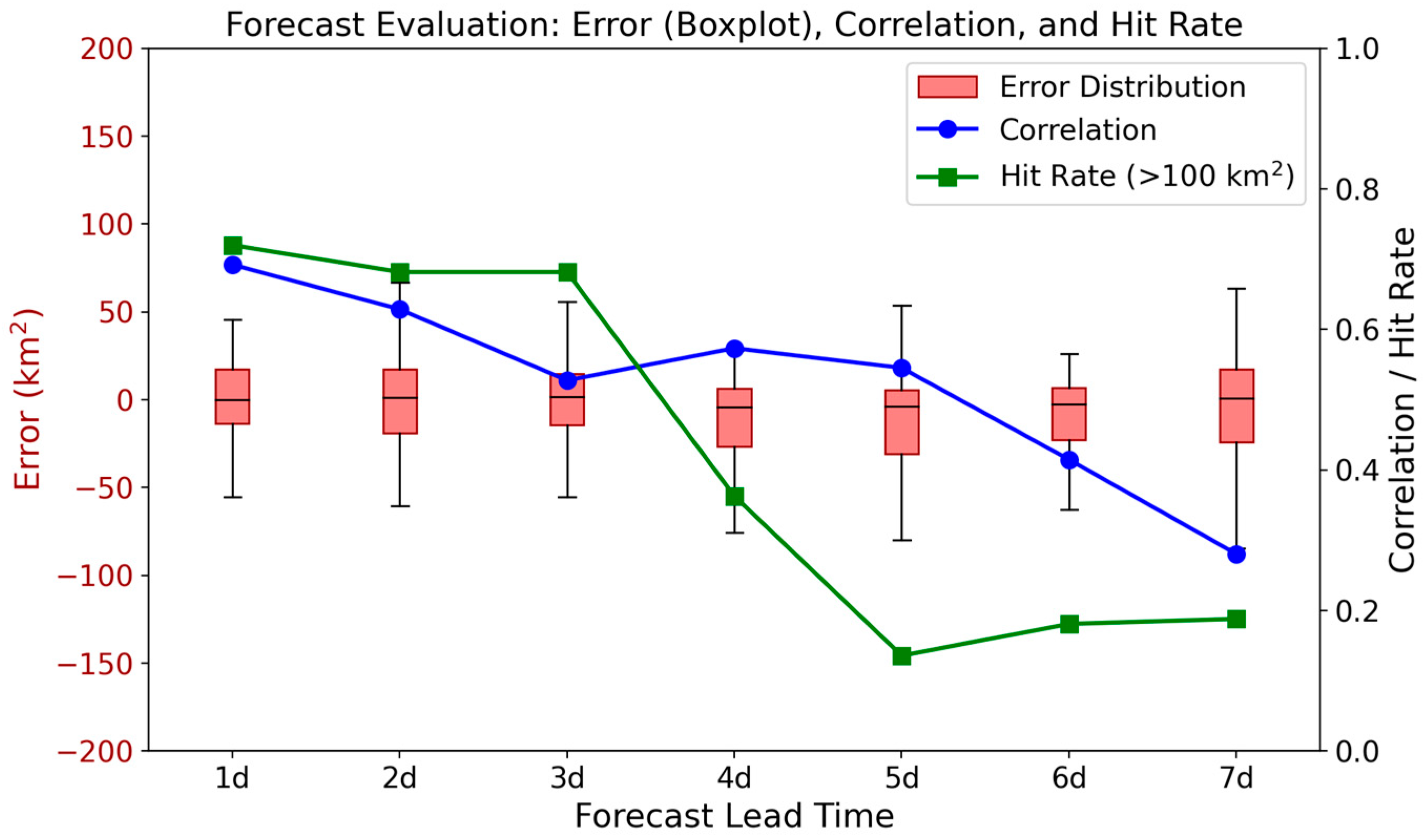Constructing Real-Time Meteorological Forecast Method of Short-Term Cyanobacteria Bloom Area Index Changes in the Lake Taihu
Abstract
1. Introduction
2. Materials and Methods
2.1. Cyanobacterial Bloom Area Monitoring
2.2. Meteorological Data and Processing Methods
2.3. Meteorological Index Construction Methodology
2.3.1. Construction of Meteorological Sub-Indices
2.3.2. Forecasting Model for Area Index
2.3.3. Model Parameters
2.3.4. Recursive Feature Elimination
2.4. Statistical Methods
3. Results
3.1. Variation Characteristics of Cyanobacterial Bloom Coverage in Lake Taihu
3.2. Correlations Analysis Between Meteorological Variables and Cyanobacterial Bloom Area in Lake Taihu
3.3. Screening of Key Meteorological Sub-Indices
3.4. Forecast Evaluation of Cyanobacterial Bloom Area Index in Lake Taihu
3.5. Real-Time Forecast Verification of Cyanobacterial Bloom Area in Lake Taihu
4. Discussion
4.1. Impact of Key Meteorological Sub-Indices on Lake Taihu Cyanobacterial Bloom Area
4.2. Analysis of Meteorological Forecast Performance for Lake Taihu Cyanobacterial Bloom Area Index
5. Conclusions
Author Contributions
Funding
Institutional Review Board Statement
Informed Consent Statement
Data Availability Statement
Conflicts of Interest
References
- Qin, B.; Gao, G.; Zhu, G.; Zhang, Y.; Song, Y.; Tang, X.; Xu, H.; Deng, J. Lake eutrophication and its ecosystem response. Chin. Sci. Bull. 2013, 58, 961–970. [Google Scholar] [CrossRef]
- Kong, F.; Gao, G. Hypothesis on cyanobacteria bloom-forming mechanisam in large shallow eutrophic lakes. Acta Ecol. Sin. 2005, 25, 589–595. [Google Scholar] [CrossRef]
- Huisman, J.; Codd, G.A.; Paerl, H.W.; Ibelings, B.W.; Verspagen, J.M.H.; Visser, P.M. Cyanobacterial blooms. Nat. Rev. Microbiol. 2018, 16, 471–483. [Google Scholar] [CrossRef]
- Taranu, Z.E.; Gregory-Eaves, I.; Leavitt, P.R.; Bunting, L.; Buchaca, T.; Catalan, J.; Domaizon, I.; Guilizzoni, P.; Lami, A.; McGowan, S.; et al. Acceleration of cyanobacterial dominance in north temperate-subarctic lakes during the Anthropocene. Ecol. Lett. 2015, 18, 375–384. [Google Scholar] [CrossRef]
- Michalak, A.M.; Anderson, E.J.; Beletsky, D.; Boland, S.; Bosch, N.S.; Bridgeman, T.B.; Chaffin, J.D.; Cho, K.; Confesor, R.; Daloğlu, I.; et al. Record setting algal bloom in Lake Erie caused by agricultural and meteorological trends consistent with expected future conditions. Proc. Natl. Acad. Sci. USA 2013, 110, 6448–6452. [Google Scholar] [CrossRef] [PubMed]
- Yang, Z.; Li, Y.; Zhu, G.; Kang, H.; Li, N.; Zhang, Y.; Qin, B. Control factors of cyanobacterial bloom area in Lake Taihu, China (2003–2023). J. Lake Sci. 2025, 37, 734–751. [Google Scholar] [CrossRef]
- Dai, Y.; Yang, S.; Zhao, D.; Hu, C.; Xu, W.; Anderson, D.M.; Li, Y.; Song, X.P.; Boyce, D.G.; Gibson, L.; et al. Coastal phytoplankton blooms expand and intensify in the 21st century. Nature 2023, 615, 280–284. [Google Scholar] [CrossRef] [PubMed]
- Stumpf, R.D.; Johnson, L.T.; Wynne, T.T.; Baker, D.B. Forecasting annual cyanobacterial bloom biomass to inform management decisions in Lake Erie. J. Great Lakes Res. 2016, 42, 1174–1183. [Google Scholar] [CrossRef]
- Qin, B.; Zhu, G.; Gao, G.; Zhang, Y.; Li, W.; Paerl, H.W.; Carmichael, W.W. A drinking water crisis in Lake Taihu, China: Linkage to climatic variability and lake management. Environ. Manag. 2010, 45, 105–112. [Google Scholar] [CrossRef]
- Qin, B.; Li, W.; Zhu, G.; Zhang, Y.; Wu, T.; Gao, G. Cyanobacterial bloom management through integrated monitoring and forecasting in large shallow eutrophic Lake Taihu (China). J. Hazard. Mater. 2015, 287, 356–363. [Google Scholar] [CrossRef]
- Yang, L.; Yang, X.; Ren, L.; Qian, X.; Xiao, L. Mechanism and control strategy of cyanobacterial bloom in Lake Taihu. J. Lake Sci. 2019, 31, 10. [Google Scholar] [CrossRef][Green Version]
- Li, W.; Qin, B. Dynamics of spatiotemporal heterogeneity of cyanobacterial blooms in large eutrophic Lake Taihu, China. Hydrobiologia 2019, 833, 81–93. [Google Scholar] [CrossRef]
- Qi, L.; Hu, C.; Visser, P.M.; Ma, R. Diurnal changes of cyanobacteria blooms in Lake Taihu as derived from GOCI observations. Limnol. Oceanogr. 2018, 63, 1711–1726. [Google Scholar] [CrossRef]
- Shi, K.; Zhang, Y.; Zhou, Y.; Liu, X.; Zhu, G.; Qin, B.; Gao, G. Long-term MODIS observations of cyanobacterial dynamics in Lake Taihu: Responses to nutrient enrichment and meteorological factors. Sci. Rep. 2017, 7, 40326. [Google Scholar] [CrossRef] [PubMed]
- Wang, S.; Zhang, X.; Chen, N.; Wang, W. Classifying diurnal changes of cyanobacterial blooms in Lake Taihu to identify hot patterns, seasons and hotspots based on hourly GOCI observations. J. Environ. Manag. 2022, 310, 114782. [Google Scholar] [CrossRef]
- Qin, B.; Yang, G.; Ma, J.; Deng, J.; Li, W.; Wu, T.; Liu, L.; Gao, G.; Zhu, G.; Zhang, Y. Dynamics of variability and mechanism of harmful cyanobacteria bloom in Lake Taihu, China. Chin. Sci. Bull. 2016, 61, 759–770. [Google Scholar] [CrossRef]
- Wu, T.; Yang, Z.G.; Qin, B.; Ma, J.; Yang, G. Movement of cyanobacterial colonies in a large, shallow and eutrophic lake: A review. Chin. Sci. Bull. 2019, 64, 3833–3843. [Google Scholar] [CrossRef]
- Li, W.; Qin, B.; Zhu, G. Forecasting short-term cyanobacterial blooms in Lake Taihu, China, using a coupled hydrodynamic-algal biomass model. Ecohydrology 2014, 7, 794–802. [Google Scholar] [CrossRef]
- Zhang, H.; Song, T.; Zhu, B.; Shi, J.; Zhang, J. Annual Forecast of the Extent of Cyanobacteria Bloom in Taihu Lake. Environ. Monit. China 2022, 38, 157–164. [Google Scholar] [CrossRef]
- Park, Y.; Lee, H.K.; Shin, J.K.; Chon, K.; Kim, S.; Cho, K.H.; Kim, J.H.; Baek, S. A machine learning approach for early warning of cyanobacterial bloom outbreaks in a freshwater reservoir. J. Environ. Manag. 2021, 288, 112415. [Google Scholar] [CrossRef] [PubMed]
- Pyo, J.; Cho, K.H.; Kim, K.; Baek, S.; Nam, G.; Park, S. Cyanobacteria cell prediction using interpretable deep learning model with observed, numerical, and sensing data assemblage. Water Res. 2021, 203, 117483. [Google Scholar] [CrossRef]
- Ni, J.; Liu, R.; Tang, G.; Xie, Y. An Improved Attention-based Bidirectional LSTM Model for Cyanobacterial Bloom Prediction. Int. J. Control. Autom. Syst. 2022, 20, 3445–3455. [Google Scholar] [CrossRef]
- Sandubete-López, J.; Fernandez-Fernandez, R.; Lopez-Orozco, J.A.; Risco-Martín, J.L. Shallow learning model for long-term cyanobacterial bloom forecasting in real-time monitoring system. Water Res. 2025, 287, 124283. [Google Scholar] [CrossRef]
- Fournier, C.; Fernandez-Fernandez, R.; Cirés, S.; López-Orozco, J.A.; Besada-Portas, E.; Quesada, A. LSTM networks provide efficient cyanobacterial blooms forecasting even with incomplete spatio-temporal data. Water Res. 2024, 267, 122553. [Google Scholar] [CrossRef] [PubMed]
- Binding, C.E.; Greenberg, T.A.; McCullough, G.; Watson, S.B.; Page, E. An analysis of satellite-derived chlorophyll and algal bloom indices on Lake Winnipeg. J. Great Lakes Res. 2018, 44, 436–446. [Google Scholar] [CrossRef]
- Zhang, M.; Yang, Z.; Shi, X. Expansion and drivers of cyanobacterial blooms in Lake Taihu. J. Lake Sci. 2019, 31, 336–344. [Google Scholar] [CrossRef]
- Hang, X.; Luo, X.; Xie, X.; Li, Y. Suitable Meteorological Indicators for Formation of Cyanobacteria Blooms in Lake Taihu. Meteor. Sci. Tec. 2019, 47, 171–178. [Google Scholar] [CrossRef]
- Ma, R.; Kong, F.; Duan, H.; Zhang, S.; Kong, W.; Hao, J. Spatio-temporal distribution of cyanobacteria blooms based on satellite imageries in Lake Taihu, China. J. Lake Sci. 2008, 20, 687–694. [Google Scholar] [CrossRef]
- Huang, Y.; Guo, B.; Sun, H.; Liu, H.; Chen, S.X. Relative importance of meteorological variables on air quality and role of boundary layer height. Atmos. Environ. 2021, 267, 118737. [Google Scholar] [CrossRef]
- HJ 1098—2020; Technical Specifications for Monitoring and Evaluating Algal Bloom Based on Remote Sensing and Field Monitoring. China Environment Press: Beijing, China, 2020. Available online: https://www.mee.gov.cn/ywgz/fgbz/bz/bzwb/other/qt/202002/W020200213479102762551.pdf (accessed on 16 September 2025).
- Wolpert, D.H. Stacked generalization. Neural Netw. 1992, 5, 241–259. [Google Scholar] [CrossRef]
- Michael, A.N. Neural Networks and Deep Learning; Determination Press. 2015. Available online: http://neuralnetworksanddeeplearning.com/ (accessed on 16 September 2025).
- Chen, T.; Guestrin, C.E. XGBoost: A scalable tree boosting system. In Proceedings of the 22nd ACM SIGKDD International Conference on Knowledge Discovery and Data Mining, San Francisco, CA, USA, 13–17 August 2016; pp. 785–794. [Google Scholar] [CrossRef]
- Liu, X.; Zhang, G. A review of studies on the impact of climate change on cyanobacteria blooms in lakes. Adv. Water Sci. 2022, 33, 316–326. [Google Scholar] [CrossRef]
- Song, T.; Zhang, H.; Xu, Y.; Dai, X.; Fan, F.; Wang, Y.; Liu, G. Cyanobacterial blooms in Lake Taihu: Temporal trends and potential drivers. Sci. Total Environ. 2024, 942, 173684. [Google Scholar] [CrossRef]
- Hu, Z.; Xue, F.; Jin, R.; Sun, J.; Song, W.; Gao, B. Design and implementation of gridded forecast application platform. Meteorol. Mon. 2020, 46, 1340–1350. [Google Scholar] [CrossRef]
- Luo, X.; Hang, X.; Cao, Y.; Hang, R.; Li, Y. Dominant meteorological factors affecting cyanobacterial blooms under eutrophication in Lake Taihu. J. Lake Sci. 2019, 031, 1248–1258. [Google Scholar] [CrossRef]
- Ding, W.; Li, Y.; Xu, S.; Li, J.; Zhao, J.; Ruan, S.; Wang, Y. Characteristics of surface lake current and its effect on cyanobacteria migration in Lake Taihu under changing wind field. J. Hohai Univ. (Nat. Sci.) 2022, 50, 58–65. [Google Scholar] [CrossRef]
- Huang, J.; Zhang, Y.; Arhonditsis, G.B.; Gao, J.; Chen, Q.; Peng, J. The magnitude and drivers of harmful algal blooms in China’s lakes and reservoirs: A national-scale characterization. Water Res. 2020, 181, 115902. [Google Scholar] [CrossRef]
- Zhu, G.; Shi, K.; Li, M.; Li, N.; Zou, W.; Guo, C.; Zhu, M.; Xu, H.; Zhang, Y.; Qin, B. Seasonal forecast method of cyanobacterial bloom intensity in eutrophic Lake Taihu, China. J. Lake Sci. 2020, 32, 11. [Google Scholar] [CrossRef]








| Meteorological Factor | Calculation Method | Meteorological Factor | Calculation Method |
|---|---|---|---|
| Hourly mean wind direction | The wind direction of the vector sum under the assumption of uniform wind speed | Wind direction, wind speed, wind direction variance, and wind speed variance from 08:00 to 14:00 | based on the wind field data from 08:00 to 14:00 |
| Hourly mean wind speed | Daily mean temperature () | Average temperature form all the stations and all the hours | |
| Hourly wind direction variance | 5-day accumulated temperature (AT) | ||
| Hourly wind speed variance | 5-day accumulated temperature variation (dAT) | ||
| Daily mean wind speed () | Daily precipitation (Pre) | Average daily precipitation form all the stations | |
| Daily wind speed variance | Precipitation in the previous 1–3 days () | ||
| Daily mean wind direction () | Daily-averaged vectors of | Daily mean RH | Dongshan Station |
| Daily wind direction variance | Daily average air pressure | Dongshan Station | |
| Daily maximum wind speed | The maximum value of in a single day | Daily average cloud cover | Dongshan Station |
| 6-h mean wind speed | based on 6-h moving window wind field data, processed in the same manner as the daily wind direction/speed variance computation method | Daily average evaporation | Dongshan Station |
| 6-h mean wind direction | Daily minimum visibility | Dongshan Station | |
| 6-h wind direction variance | Sunshine duration | Dongshan Station | |
| 6-h wind speed variance |
| XGBoost (1) | XGBoost (2) | XGBoost (3) | |
|---|---|---|---|
| Number of Trees | 200 | 150 | 100 |
| Max Depth | 4 | 2 | 2 |
| Learning Rate | 0.05 | 0.10 | 0.09 |
| L2 Regularization Weight | 1.00 | 1.00 | 1.00 |
| Meteorological Factors | Correlations with Meteorological Sub-Indices | Correlations with Meteorological Factors Values | Meteorological Factors | Correlations with Meteorological Sub-Indices | Correlations with Meteorological Factors Values | ||||
|---|---|---|---|---|---|---|---|---|---|
| Coefficient | Rank | Coefficient | Rank | Coefficient | Rank | Coefficient | Rank | ||
| 08:00–14:00 mean wind speed (V1) | 0.44 | 1 | −0.41 | 1 | Daily max wind speed (V16) | 0.22 | 16 | −0.21 | 13 |
| 08:00–14:00 wind speed variance (V2) | 0.41 | 2 | −0.29 | 2 | Daily evaporation (V17) | 0.21 | 18 | 0.25 | 8 |
| Daily minimum 6-h wind speed variance (V3) | 0.40 | 3 | −0.28 | 5 | Daily mean RH (V18) | 0.18 | 19 | 0.20 | 14 |
| 08:00–14:00 wind direction variance (V4) | 0.39 | 4 | 0.22 | 10 | Previous-day max 6-h wind speed variance (V19) | 0.17 | 20 | −0.10 | 25 |
| Daily maximum 6-h wind direction variance (V5) | 0.36 | 5 | 0.22 | 12 | Daily Precipitation (V20) | 0.17 | 21 | 0.04 | 29 |
| Daily mean wind direction variance (V6) | 0.32 | 6 | 0.27 | 6 | Daily min 6-h wind direction variation (V21) | 0.16 | 22 | 0.14 | 22 |
| Daily wind direction variance (V7) | 0.32 | 7 | 0.16 | 18 | Daily wind speed variance (V22) | 0.15 | 23 | −0.07 | 28 |
| 5-day accumulated temperature (V8) | 0.31 | 8 | 0.28 | 4 | Sunshine duration (V23) | 0.14 | 24 | −0.02 | 31 |
| Daily minimum visibility (V9) | 0.30 | 9 | −0.15 | 19 | Daily mean wind direction (V24) | 0.14 | 25 | −0.09 | 26 |
| Daily mean temperature (V10) | 0.28 | 10 | 0.29 | 3 | Daily average air pressure (V25) | 0.13 | 26 | −0.25 | 9 |
| Daily mean wind speed (V11) | 0.28 | 11 | −0.26 | 7 | Daily average cloud cover (V26) | 0.13 | 27 | 0.14 | 21 |
| Precipitation in the previous 1–3 days (V12) | 0.27 | 12 | 0.20 | 15 | Previous-day max hourly wind speed variance (V27) | 0.11 | 28 | −0.14 | 20 |
| Previous-day mean wind speed (V13) | 0.25 | 13 | −0.22 | 11 | dAT (V28) | 0.08 | 30 | 0.01 | 32 |
| Daily max 6-h wind speed variance (V14) | 0.25 | 14 | −0.16 | 17 | Daily max hourly wind speed variance (V29) | 0.08 | 31 | −0.13 | 23 |
| Previous-day wind speed variance (V15) | 0.23 | 15 | 0.04 | 30 | Previous-day max hourly wind speed (V30) | 0.06 | 32 | −0.12 | 24 |
| Models | Optimal Combination of Input Indices |
|---|---|
| AA | V2, V5, V4, V12, V19, V15, V20, V1, V8, V7, V9, V29, V25, V3, V10, V18, V27, V24, V28, V22, V26 |
| MLP | V2, V5, V4, V15, V12, V10, V3, V1, V9, V25, V20, V7, V22, V29, V26, V28 |
| BP | V4, V21, V12, V13, V8, V30, V15, V20, V7, V2, V22, V29, V27, V18, V10, V24, V19 |
| XGBoost(1) | V2, V4, V1, V22, V5, V3, V8, V26, V10, V12, V27, V30, V23, V24, V15, V19, V20 |
| Train Data The 5-Fold Cross-Validation Coefficient of Determination (R2) | Test Data (80) | |||||
|---|---|---|---|---|---|---|
| Deciding Coefficient (R2) | RMSE | >0.3 False Positive Rate | >0.3 False Negative Rate | >0.3 Hit Rate | ||
| XGBoost (2) | 0.87 | 0.64 | 0.07 | 10% | 5% | 85% |
| XGBoost (3) | 0.90 | 0.70 | 0.06 | 8% | 5% | 87% |
Disclaimer/Publisher’s Note: The statements, opinions and data contained in all publications are solely those of the individual author(s) and contributor(s) and not of MDPI and/or the editor(s). MDPI and/or the editor(s) disclaim responsibility for any injury to people or property resulting from any ideas, methods, instructions or products referred to in the content. |
© 2025 by the authors. Licensee MDPI, Basel, Switzerland. This article is an open access article distributed under the terms and conditions of the Creative Commons Attribution (CC BY) license (https://creativecommons.org/licenses/by/4.0/).
Share and Cite
Wang, J.; Zhao, J.; Hua, C.; Zhang, J. Constructing Real-Time Meteorological Forecast Method of Short-Term Cyanobacteria Bloom Area Index Changes in the Lake Taihu. Sustainability 2025, 17, 8376. https://doi.org/10.3390/su17188376
Wang J, Zhao J, Hua C, Zhang J. Constructing Real-Time Meteorological Forecast Method of Short-Term Cyanobacteria Bloom Area Index Changes in the Lake Taihu. Sustainability. 2025; 17(18):8376. https://doi.org/10.3390/su17188376
Chicago/Turabian StyleWang, Jikang, Junying Zhao, Cong Hua, and Jianzhong Zhang. 2025. "Constructing Real-Time Meteorological Forecast Method of Short-Term Cyanobacteria Bloom Area Index Changes in the Lake Taihu" Sustainability 17, no. 18: 8376. https://doi.org/10.3390/su17188376
APA StyleWang, J., Zhao, J., Hua, C., & Zhang, J. (2025). Constructing Real-Time Meteorological Forecast Method of Short-Term Cyanobacteria Bloom Area Index Changes in the Lake Taihu. Sustainability, 17(18), 8376. https://doi.org/10.3390/su17188376






